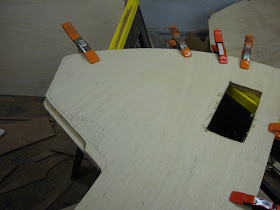More and more boat parts emerged from plywood as my saw once again sliced through the thin sheets of okoume today. Joining the growing pile of parts were the cabin deck halves, cockpit deck halves, cockpit sides, and many more parts. Most of the cuts were made with my trusty circular saw. For parts that are the same port and starboard, I'd stack two pieces of plywood and cut both parts at the same time.
 |
| Cabin deck halves (both halves cut at the same time) |
I also cut out the centerboard halves. The centerboard will consist of two pieces of 3/8" plywood glued together to form a nice 3/4" thick centerboard.
 |
| Centerboard halves, clamped together and freshly cut out. |
 |
| Disaster strikes! One half of the centerboard is missing a little something. |
One thing that I've learned in boatbuilding is that disaster WILL strike. Something will get incorrectly cut, glued, sanded, not sanded, dropped, mixed (think epoxy), or delaminated. And then you have to figure out how to undo, fix, or obfuscate your mistake. And yes, it is always YOUR mistake. Always. The key is to not kick yourself too much or get down about it. Keep a level head and think it through. Having a sanguine Norwegian temperament helps. There's always a way out. Maybe a time intensive or expensive way out, but a way out nonetheless.
Nine times out of ten, salvation comes in the form of the wood butcher's friend, epoxy. This isn't one of those times, though I suppose one solution would be to whip up a big batch of thickened epoxy and glob it into where there should have been plywood. But I'm not going to do that. The possible solutions I've come up with so far are:
1. Buy another sheet of 3/8" plywood and try again. Disadvantage: Cost.
2. Cut a small bock of plywood roughly the shape of the whats missing and bond it it when the centerboard halves are glued together. Disadvantage: It'll take frustrating fiddling to get the piece to fit just right.
3. The transom is cut out of 3/4" teak plywood. The transom requires about 1/2 a sheet of plywood, leaving a fair bit of 3/4" plywood left over. I am going to cut a couple of other parts (rudder cheeks and tabernacle) out of the remainder, but that'll still leave enough 3/4" to cut out a solid centerboard. Forget about gluing two halves together! Disadvantage #1: The centerboard has a square cut out of it into which lead will be poured so that the board will actually go down into the water when it is lowered. There is a rabbet in the center of the board cut around the perimeter of this hole so that the lead has something to hang on to. Cutting this rabbet is really easy when you have to halves waiting to be joined. Not so much fun when you have to excavate it from the 3/4 monolith. But doable. Disadvantage #2: Cost. That teak plywood is expensive. In terms of cost per unit area, I could get that whole sheet of 3/8" plywood of the cost of a centerboard-sized piece of 3/4" teak. On the other hand, I've already bought the 3/4" plywood, and I don't currently have any other plans for the wood that could make up my new centerboard. So...
I'm undecided about which way to go. I'll give it some thought, and in the meantime keep working on cutting out parts!



















